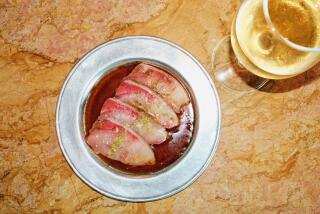HoJo’s Restaurants Are Fading Away
- Share via
BANGOR, Maine — The orange roof is long gone and the Simple Simon plaque is history. The famous 28 flavors of ice cream have dwindled to 16 varieties.
But at least the Howard Johnson’s name sits atop the building, which is a lot more than hundreds of onetime Howard Johnson’s eateries can say. The venerable chain once had more than 800 restaurants from coast to coast, but these days you can count them on two hands.
Some fear that HoJo’s and its trademark orange roofs, fried clams and timeless air will soon go the way of the Studebaker, a victim of modern times and increased competition. If that happens, an icon of American dining and one of the nation’s first full-service restaurant chains will disappear.
Waitress Kathe Jewett has watched sadly as other HoJo restaurants nationwide have been shuttered, torn down or converted into other restaurants, a fitness center, a gift shop, a bank and even a car dealership. Jewett started working here fresh out of high school 39 years ago, and has seen generations pass through these doors.
“It’s a way of life,” Jewett said. “Now there are chain restaurants on every corner.”
The decline began after the company was sold to Imperial Group, a British conglomerate, 25 years ago, said Walter Mann of North Haven, Conn., who runs HoJoLand, a website devoted to Howard Johnson’s. It was then sold two more times before ending up in the hands of Franchise Associates Inc., a Shelton, Conn., company that has owned it since 1986.
With this month’s closing of a HoJo’s in Springfield, Vt., there are now only eight left in Maine, Connecticut, Michigan, New Jersey, Maryland and New York, Mann said. The Howard Johnson’s in New York City’s Times Square is reportedly going to close in June.
The future for the chain is unclear. Franchise Associates did not return several phone calls left on its answering machines. Its website is dated with old information and an old phone number and address in Duxbury, Mass.
“It’s definitely twilight time for Howard Johnson’s,” Mann said.
Howard Deering Johnson started the business that bears his name in 1925, when he inherited from his father a small soda fountain outside Boston. Customers started flocking his way after he began serving ice cream with twice the usual butterfat.
Johnson added other easy-to-fix foods like hot dogs and fried clams to the menu, and three years later opened the first Howard Johnson’s restaurant. In the decades to come, the Howard Johnson’s name spread as hundreds of franchises opened across the country.
The Howard Johnson hotel chain, which is separate from the restaurants, came later. The first motor lodge opened in 1954, and there are still 464 Howard Johnson hotels around. They are franchised by New York-based Cendant Corp. but are not affiliated with the restaurants.
At the peak, there were 850 or so Howard Johnson’s restaurants, as well as close to 200 company-owned Ground Rounds and a couple of dozen Red Coach Grills, according to Rich Kummerlowe of Spring Hill, Fla. Kummerlowe has a website -- America’s Landmark, Under the Orange Roof -- that pays tribute to Howard Johnson’s, and has studied the chain as a board member of the Society for Commercial Archeology, an organization devoted to the 20th-century commercial landscape.
Johnson did for roadside restaurants what Holiday Inn, the first national lodging chain, did for roadside hotels. HoJo’s is also credited with being one of the first companies to package its buildings -- orange roofs, cupolas with weather vanes, and the Simple Simon and Pieman plaques -- to market its product, much the way McDonald’s later used its golden arches.
Over time, the chain suffered from aging restaurants, a stale menu and a lack of marketing and new ideas, as well as increased competition from chains such as Applebee’s, Chili’s and Ruby Tuesday, Kummerlowe said. One by one, the restaurants began closing their doors.
“There was no vision, and there was no capital that was reinvested,” he said.
If the chain goes under, it will be a loss for generations of Americans who still have warm and fuzzy memories of the restaurants, said Ron Nykiel, the founder and president of the Hospitality Hall of Honor at the University of Houston. Howard Johnson was inducted posthumously in 1999.
Nykiel remembers as a child piling into the family Buick for the annual summer vacation drive from New Jersey to Canada, stopping at Howard Johnson’s along the way for hot dogs and ice cream. For others, it conjures up blueberry and corn toastees, salt-water taffy and old-fashioned waitress uniforms.
“You don’t have a bad memory of Howard Johnson’s,” Nykiel said.
At the Bangor Howard Johnson’s, the waitresses call the noontime customers “hon” or “dear” or by name. The original lunch counter is still here, as is the milkshake machine and the stainless-steel coolers behind the counter.
Marjorie and Ernest Melvin come here nearly every day. Now in their 80s, they like going to a place where the food is good, the prices are moderate and they feel like family. Still, Marjorie Melvin says, the restaurant could stand to change.
“Right now I wish they’d change their menus a little bit,” she said. “I like their food, I’m just a bit tired of it.”
Some still hold hope for the chain. Other chains, after all, have teetered on the brink and come back stronger than ever.
“The key is, who is the white knight for HoJo’s?” Mann said.
More to Read
Inside the business of entertainment
The Wide Shot brings you news, analysis and insights on everything from streaming wars to production — and what it all means for the future.
You may occasionally receive promotional content from the Los Angeles Times.










